The Origins Of Jamaican Oxtail
Though oxtail in all of its forms may be among the most famous Jamaican recipes today, the cut didn't always get the credit it deserved. Elevated out of necessity, oxtail's long history transformed it from a throwaway piece of meat into one of the best cuts for tender braised beef.
At the start of the 16th century, enslaved people were brought to Jamaica from Africa. Because the land couldn't support vast herds of beef cattle, the available meat animals were largely limited to those that could live off the land, like goats, and beasts of burden, like oxen. While wealthy residents of the island may have dined on expensive cuts of beef like steaks, enslaved people were forced to make do with off-cuts like snout, foot, and tail. Between the diverse African cooking styles of their native lands and the varying availability of ingredients like allspice, thyme, and ginger, a dizzying variety of ways to prepare oxtail emerged.
Though it may be a relatively small country, regional varieties of Jamaican oxtail stew, curry, and barbecue based on these historic recipes abound. Some practices, like searing the meat first, are fairly widespread and found in almost all recipes. Others may show more Spanish, Irish, Creole, or even Taino — the indigenous people of Jamaica — influence. Regardless of the reason, from the 16th century to today, generations of cooks transformed oxtail from something once perceived as trash into one of the priciest cuts at a butcher's counter.
Patience transforms oxtail into a tender, flavorful dish
A tough meat full of cartilage, connective tissue, and bone, oxtail isn't as simple to prepare as a steak, rack of ribs, or cheek. However, those same qualities that make it difficult to work with also make it one of the best cuts of meat for beef curry, stews, and other slow-cooked dishes.
Most oxtail recipes revolve around tenderizing it in a spice-rich broth. This low and slow heat melts collagen into flavorful juices, breaks down cartilage, and draws taste out of the bones, producing something rich, beefy, and complex. However, since oxtail has been historically prepared with African influences, smoking it with the same methods used for pork shoulder or brisket isn't uncommon. As long as your recipe allows for at least three or four hours of cooking time and won't dry the meat out, oxtail is forgiving enough to prepare in many ways.
What separates oxtail from most other Western stews and barbecues are the ingredients. As a place once infamous for its sugar plantations, it's common to see sweeteners in oxtail stew, which complement the abundant fat and help cultivate a deep, caramel color in the meat. When paired with mulling spices, herbs, and peppers, you get something floral, rich, sweet, and savory — a dish as complex as anything you'd find in a Michelin-starred restaurant. Served with starches to soak up the juices, fried plantains to bulk out the meal, or salads to provide some fresh crispness, Jamaican oxtail is an icon on any family's table.


